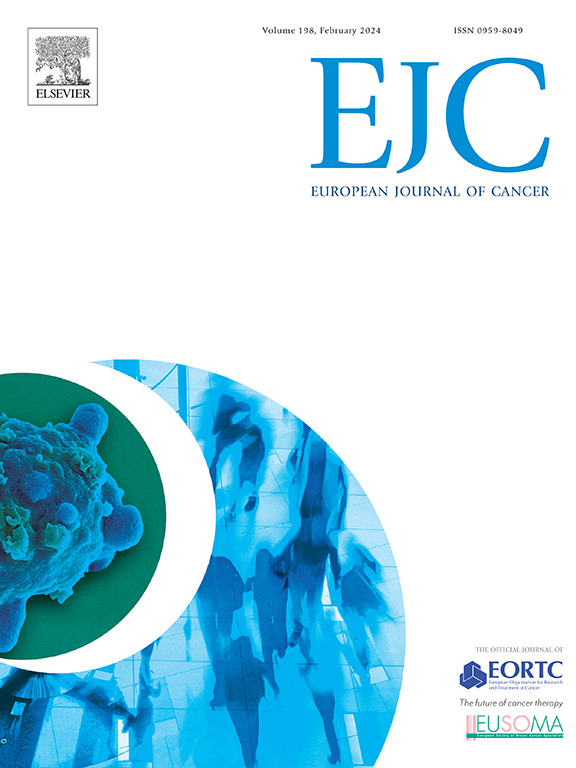使用Merlin试验(CP-GEP)对930例未接受前哨淋巴结活检的临床I/II期黑色素瘤患者进行风险分层
IF 7.6
1区 医学
Q1 ONCOLOGY
引用次数: 0
摘要
超过80% %的黑色素瘤患者被诊断为无淋巴结转移,但大多数复发或死于黑色素瘤的患者最初被诊断为低风险早期。在这里,我们研究了Merlin试验对未接受前哨淋巴结活检(SLNB)的患者进行复发风险分层的能力。患者和方法对2000年至2020年在图宾根大学诊断的930例临床I/II期原发性皮肤黑色素瘤患者进行分析。所有患者均未接受SLNB手术。Merlin试验结合了患者在诊断时的年龄、Breslow厚度和来自原发肿瘤的8种特定基因的基因表达。风险输出标签分为高风险和低风险。结果临床病理基因表达谱(CP-GEP)鉴定879例为低危,51例为高危。10年RFS (HR 20.07;p <; 0.001)和DMFS (HR 19.39;p <; 0.001)在CP-GEP低危患者中显著高于高危患者。10年MSS组也有类似的结果(HR 35.85;p & lt; 0.001)。慢斑恶性黑色素瘤和肢端慢斑黑色素瘤的CP-GEP分析表明,该方法的性能与黑色素瘤的组织学亚型无关。结论本研究表明,CP-GEP有可能根据复发风险对未行SLNB的早期黑色素瘤患者进行分层。CP-GEP低危患者的长期生存率明显提高。CP-GEP有望指导SLNB转诊,并可能通过优化个性化治疗计划和潜在的监测方案来支持黑色素瘤的护理。本文章由计算机程序翻译,如有差异,请以英文原文为准。
Risk stratification using the Merlin Assay (CP-GEP) in an independent cohort of 930 patients with clinical stage I/II melanoma who did not undergo sentinel lymph node biopsy
Purpose
More than 80 % of patients with melanoma are diagnosed without nodal metastasis, but most of those who relapse or die from melanoma are initially diagnosed as low risk early-stage. Here we investigate the ability of the Merlin Assay to stratify patients who did not undergo sentinel lymph node biopsy (SLNB) for their risk of recurrence.
Patients and methods
930 patients with clinical stage I/II primary cutaneous melanoma from the University of Tuebingen diagnosed between 2000 and 2020 were analyzed. None of the patients included underwent SLNB. The Merlin Assay combines patient age at diagnosis, Breslow thickness, and gene expression of eight specific genes from the primary tumor. Risk output labels are High Risk and Low Risk.
Results
Clinicopathological gene expression profile (CP-GEP) identified 879 patients as Low Risk and 51 patients as High Risk. The 10-year RFS (HR 20.07; p < 0.001) and DMFS (HR 19.39; p < 0.001) were significantly higher in CP-GEP Low Risk versus High Risk patients. Similar results were observed in 10-year MSS (HR 35.85; p < 0.001). CP-GEP analysis of lentigo maligna melanoma and acral lentiginous melanoma showed that the performance of assay was independent of melanoma histological subtypes.
Conclusion
This study shows that CP-GEP has the potential to stratify patients with early-stage melanoma who did not undergo SLNB based on their risk of recurrence. Patients with CP-GEP Low Risk have a significantly better long-term survival. CP-GEP shows to be promising for guiding SLNB referral and may support melanoma care by optimizing personalized treatment plans and potential surveillance regimens.
求助全文
通过发布文献求助,成功后即可免费获取论文全文。
去求助
来源期刊

European Journal of Cancer
医学-肿瘤学
CiteScore
11.50
自引率
4.80%
发文量
953
审稿时长
23 days
期刊介绍:
The European Journal of Cancer (EJC) serves as a comprehensive platform integrating preclinical, digital, translational, and clinical research across the spectrum of cancer. From epidemiology, carcinogenesis, and biology to groundbreaking innovations in cancer treatment and patient care, the journal covers a wide array of topics. We publish original research, reviews, previews, editorial comments, and correspondence, fostering dialogue and advancement in the fight against cancer. Join us in our mission to drive progress and improve outcomes in cancer research and patient care.
 求助内容:
求助内容: 应助结果提醒方式:
应助结果提醒方式:


